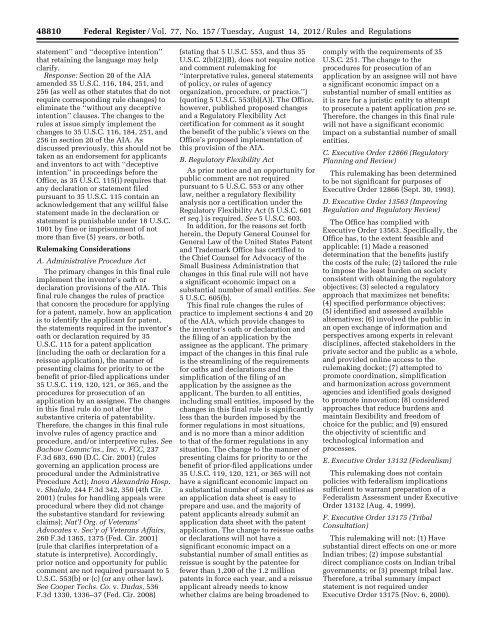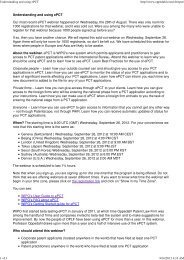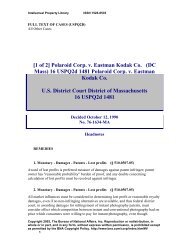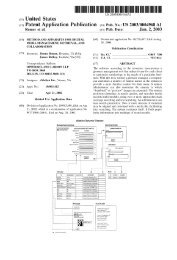48810 Federal Register / Vol. 77, No. 157 / Tuesday, August 14, 2012 / Rules and Regulationssro<strong>be</strong>rts on DSK5SPTVN1PROD with RULESstatement’’ and ‘‘deceptive intention’’that retaining the language may helpclarify.Response: Section 20 of the AIAamended 35 U.S.C. 116, 184, 251, and256 (as well as other statutes that do notrequire corresponding rule changes) toeliminate the ‘‘without any deceptiveintention’’ clauses. The changes to therules at issue simply implement thechanges to 35 U.S.C. 116, 184, 251, and256 in section 20 of the AIA. Asdiscussed previously, this should not <strong>be</strong>taken as an endorsement for applicantsand inventors to act with ‘‘deceptiveintention’’ in proceedings <strong>be</strong>fore theOffice, as 35 U.S.C. 115(i) requires thatany declaration or statement filedpursuant to 35 U.S.C. 115 contain anacknowledgement that any willful falsestatement made in the declaration orstatement is punishable under 18 U.S.C.1001 by fine or imprisonment of notmore than five (5) years, or both.Rulemaking ConsiderationsA. Administrative Procedure ActThe primary changes in this final ruleimplement the inventor’s oath ordeclaration provisions of the AIA. Thisfinal rule changes the rules of practicethat concern the procedure for applyingfor a patent, namely, how an applicationis to identify the applicant for patent,the statements required in the inventor’soath or declaration required by 35U.S.C. 115 for a patent application(including the oath or declaration for areissue application), the manner ofpresenting claims for priority to or the<strong>be</strong>nefit of prior-filed applications under35 U.S.C. 119, 120, 121, or 365, and theprocedures for prosecution of anapplication by an assignee. The changesin this final rule do not alter thesubstantive criteria of patentability.Therefore, the changes in this final ruleinvolve rules of agency practice andprocedure, and/or interpretive rules. SeeBachow Commc’ns., Inc. v. FCC, 237F.3d 683, 690 (D.C. Cir. 2001) (rulesgoverning an application process areprocedural under the AdministrativeProcedure Act); Inova Alexandria Hosp.v. Shalala, 244 F.3d 342, 350 (4th Cir.2001) (rules for handling appeals wereprocedural where they did not changethe substantive standard for reviewingclaims); Nat’l Org. of Veterans’Advocates v. Sec’y of Veterans Affairs,260 F.3d 1365, 1375 (Fed. Cir. 2001)(rule that clarifies interpretation of astatute is interpretive). Accordingly,prior notice and opportunity for publiccomment are not required pursuant to 5U.S.C. 553(b) or (c) (or any other law).See Cooper Techs. Co. v. Dudas, 536F.3d 1330, 1336–37 (Fed. Cir. 2008)(stating that 5 U.S.C. 553, and thus 35U.S.C. 2(b)(2)(B), does not require noticeand comment rulemaking for‘‘interpretative rules, general statementsof policy, or rules of agencyorganization, procedure, or practice.’’)(quoting 5 U.S.C. 553(b)(A)). The Office,however, published proposed changesand a Regulatory Flexibility Actcertification for comment as it soughtthe <strong>be</strong>nefit of the public’s views on theOffice’s proposed implementation ofthis provision of the AIA.B. Regulatory Flexibility ActAs prior notice and an opportunity forpublic comment are not requiredpursuant to 5 U.S.C. 553 or any otherlaw, neither a regulatory flexibilityanalysis nor a certification under theRegulatory Flexibility Act (5 U.S.C. 601et seq.) is required. See 5 U.S.C. 603.In addition, for the reasons set forthherein, the Deputy General Counsel forGeneral Law of the United States Patentand Trademark Office has certified tothe Chief Counsel for Advocacy of theSmall Business Administration thatchanges in this final rule will not havea significant economic impact on asubstantial num<strong>be</strong>r of small entities. See5 U.S.C. 605(b).This final rule changes the rules ofpractice to implement sections 4 and 20of the AIA, which provide changes tothe inventor’s oath or declaration andthe filing of an application by theassignee as the applicant. The primaryimpact of the changes in this final ruleis the streamlining of the requirementsfor oaths and declarations and thesimplification of the filing of anapplication by the assignee as theapplicant. The burden to all entities,including small entities, imposed by thechanges in this final rule is significantlyless than the burden imposed by theformer regulations in most situations,and is no more than a minor additionto that of the former regulations in anysituation. The change to the manner ofpresenting claims for priority to or the<strong>be</strong>nefit of prior-filed applications under35 U.S.C. 119, 120, 121, or 365 will nothave a significant economic impact ona substantial num<strong>be</strong>r of small entities asan application data sheet is easy toprepare and use, and the majority ofpatent applicants already submit anapplication data sheet with the patentapplication. The change to reissue oathsor declarations will not have asignificant economic impact on asubstantial num<strong>be</strong>r of small entities asreissue is sought by the patentee forfewer than 1,200 of the 1.2 millionpatents in force each year, and a reissueapplicant already needs to knowwhether claims are <strong>be</strong>ing broadened toVerDate Mar2010 17:28 Aug 13, 2012 Jkt 226001 PO 00000 Frm 00036 Fmt 4701 Sfmt 4700 E:\FR\FM\14AUR6.SGM 14AUR6comply with the requirements of 35U.S.C. 251. The change to theprocedures for prosecution of anapplication by an assignee will not havea significant economic impact on asubstantial num<strong>be</strong>r of small entities asit is rare for a juristic entity to attemptto prosecute a patent application pro se.Therefore, the changes in this final rulewill not have a significant economicimpact on a substantial num<strong>be</strong>r of smallentities.C. Executive Order 12866 (RegulatoryPlanning and Review)This rulemaking has <strong>be</strong>en determinedto <strong>be</strong> not significant for purposes ofExecutive Order 12866 (Sept. 30, 1993).D. Executive Order 13563 (ImprovingRegulation and Regulatory Review)The Office has complied withExecutive Order 13563. Specifically, theOffice has, to the extent feasible andapplicable: (1) Made a reasoneddetermination that the <strong>be</strong>nefits justifythe costs of the rule; (2) tailored the ruleto impose the least burden on societyconsistent with obtaining the regulatoryobjectives; (3) selected a regulatoryapproach that maximizes net <strong>be</strong>nefits;(4) specified performance objectives;(5) identified and assessed availablealternatives; (6) involved the public inan open exchange of information andperspectives among experts in relevantdisciplines, affected stakeholders in theprivate sector and the public as a whole,and provided online access to therulemaking docket; (7) attempted topromote coordination, simplificationand harmonization across governmentagencies and identified goals designedto promote innovation; (8) consideredapproaches that reduce burdens andmaintain flexibility and freedom ofchoice for the public; and (9) ensuredthe objectivity of scientific andtechnological information andprocesses.E. Executive Order 13132 (Federalism)This rulemaking does not containpolicies with federalism implicationssufficient to warrant preparation of aFederalism Assessment under ExecutiveOrder 13132 (Aug. 4, 1999).F. Executive Order 13175 (TribalConsultation)This rulemaking will not: (1) Havesubstantial direct effects on one or moreIndian tri<strong>be</strong>s; (2) impose substantialdirect compliance costs on Indian tribalgovernments; or (3) preempt tribal law.Therefore, a tribal summary impactstatement is not required underExecutive Order 13175 (Nov. 6, 2000).
Federal Register / Vol. 77, No. 157 / Tuesday, August 14, 2012 / Rules and Regulations48811sro<strong>be</strong>rts on DSK5SPTVN1PROD with RULESG. Executive Order 13211 (EnergyEffects)This rulemaking is not a significantenergy action under Executive Order13211 <strong>be</strong>cause this rulemaking is notlikely to have a significant adverse effecton the supply, distribution, or use ofenergy. Therefore, a Statement of EnergyEffects is not required under ExecutiveOrder 13211 (May 18, 2001).H. Executive Order 12988 (Civil JusticeReform)This rulemaking meets applicablestandards to minimize litigation,eliminate ambiguity, and reduce burdenas set forth in sections 3(a) and 3(b)(2)of Executive Order 12988 (Feb. 5, 1996).I. Executive Order 13045 (Protection ofChildren)This rulemaking does not concern anenvironmental risk to health or safetythat may disproportionately affectchildren under Executive Order 13045(Apr. 21, 1997).J. Executive Order 12630 (Taking ofPrivate Property)This rulemaking will not effect ataking of private property or otherwisehave taking implications underExecutive Order 12630 (Mar. 15, 1988).K. Congressional Review ActUnder the Congressional Review Actprovisions of the Small BusinessRegulatory Enforcement Fairness Act of1996 (5 U.S.C. 801 et seq.), the UnitedStates Patent and Trademark Office willsubmit a report containing this final ruleand other required information to theUnited States Senate, the United StatesHouse of Representatives, and theComptroller General of the GovernmentAccountability Office. The changes inthis final rule are not expected to resultin an annual effect on the economy of100 million dollars or more, a majorincrease in costs or prices, or significantadverse effects on competition,employment, investment, productivity,innovation, or the ability of UnitedStates-based enterprises to competewith foreign-based enterprises indomestic and export markets. Therefore,this final rule is not a ‘‘major rule’’ asdefined in 5 U.S.C. 804(2).L. Unfunded Mandates Reform Act of1995The changes in this rulemaking do notinvolve a Federal intergovernmentalmandate that will result in theexpenditure by State, local, and tribalgovernments, in the aggregate, of 100million dollars (as adjusted) or more inany one year, or a Federal private sectormandate that will result in theexpenditure by the private sector of 100million dollars (as adjusted) or more inany one year, and will not significantlyor uniquely affect small governments.Therefore, no actions are necessaryunder the provisions of the UnfundedMandates Reform Act of 1995. See 2U.S.C. 1501 et seq.M. National Environmental Policy ActThis rulemaking will not have anyeffect on the quality of environment andis thus categorically excluded fromreview under the NationalEnvironmental Policy Act of 1969. See42 U.S.C. 4321 et seq.N. National Technology Transfer andAdvancement ActThe requirements of section 12(d) ofthe National Technology Transfer andAdvancement Act of 1995 (15 U.S.C.272 note) are not applicable <strong>be</strong>cause thisrulemaking does not contain provisionswhich involve the use of technicalstandards.O. Paperwork Reduction ActThis rulemaking involves informationcollection requirements which aresubject to review by the Office ofManagement and Budget (OMB) underthe Paperwork Reduction Act of 1995(44 U.S.C. 3501 et seq.). The collectionof information involved in thisrulemaking has <strong>be</strong>en reviewed andpreviously approved by OMB underOMB Control Num<strong>be</strong>rs 0651–0032 and0651–0035. The primary impact of thechanges in this notice is thestreamlining of the requirements foroaths and declarations and thesimplification of the filing of anapplication by the assignee when aninventor cannot or will not execute anoath or declaration. The Office is notresubmitting an information collectionpackage to OMB for its review andapproval <strong>be</strong>cause the changes in thisrulemaking do not change patent fees orchange the information collectionrequirements (the estimated num<strong>be</strong>r ofrespondents, time per response, totalannual respondent burden hours, ortotal annual respondent cost burden)associated with the informationcollections approved under OMBControl Num<strong>be</strong>rs 0651–0032 and 0651–0035.Notwithstanding any other provisionof law, no person is required to respondto, nor shall a person <strong>be</strong> subject to apenalty for failure to comply with, acollection of information subject to therequirements of the PaperworkReduction Act, unless that collection ofinformation displays a currently validOMB control num<strong>be</strong>r.VerDate Mar2010 17:28 Aug 13, 2012 Jkt 226001 PO 00000 Frm 00037 Fmt 4701 Sfmt 4700 E:\FR\FM\14AUR6.SGM 14AUR6List of Subjects37 CFR Part 1Administrative practice andprocedure, Inventions and patents,Reporting and recordkeepingrequirements, Small businesses.37 CFR Part 3Administrative practice andprocedure, Patents, Trademarks37 CFR Part 5Classified information, Foreignrelations, Inventions and patents.37 CFR Part 10Administrative practice andprocedure, Inventions and patents,Lawyers, Reporting and recordkeepingrequirements.37 CFR Part 41Administrative practice andprocedure, Inventions and patents,Lawyers.For the reasons set forth in thepreamble, 37 CFR parts 1, 3, 5, 10 and41 are amended as follows:PART 1—RULES <strong>OF</strong> PRACTICE INPATENT CASES■ 1. The authority citation for 37 CFRPart 1 continues to read as follows:Authority: 35 U.S.C. 2(b)(2).■ 2. Section 1.1 is amended by revisingparagraph (e) to read as follows:§ 1.1 Addresses for non-trademarkcorrespondence with the United StatesPatent and Trademark Office.* * * * *(e) Patent term extension. Allapplications for extension of patent termunder 35 U.S.C. 156 and anycommunications relating theretointended for the United States Patentand Trademark Office should <strong>be</strong>additionally marked ‘‘Mail Stop Hatch-Waxman PTE.’’ When appropriate, thecommunication should also <strong>be</strong> markedto the attention of a particularindividual, as where a decision has <strong>be</strong>enrendered.* * * * *■ 3. Section 1.4 is amended by revisingparagraph (e) to read as follows:§ 1.4 Nature of correspondence andsignature requirements.* * * * *(e) The following correspondencemust <strong>be</strong> submitted with an originalhandwritten signature personally signedin permanent dark ink or its equivalent:(1) Correspondence requiring aperson’s signature and relating toregistration to practice <strong>be</strong>fore the Patent
- Page 1:
UNIFORM CERTIFICATE OF ATTENDANCE F
- Page 4 and 5:
SPTO explains the America Invents A
- Page 6 and 7:
PTO/SB/01A (01-09)Approved for use
- Page 8 and 9:
PTO/SB/ (06-12)Approved for use thr
- Page 10 and 11:
PTO/ (06-12)Approved for use throug
- Page 12 and 13:
PTO/(06-1Approved for use through 0
- Page 14 and 15:
What will change about the oath ord
- Page 16 and 17:
Action item●●●If you have not
- Page 18 and 19:
But 37 CFR § 1.63 says:A person ma
- Page 20 and 21:
●●●Combined assignment anddec
- Page 22 and 23:
●●●●●●Consequences of i
- Page 24 and 25:
How to file the ADSs●●If you pr
- Page 26 and 27:
Supplemental ADSAny ADS filed after
- Page 28 and 29:
Provisionals●●●Rules are a bi
- Page 30 and 31:
Are all assignees applicants?●●
- Page 32 and 33:
Substitute Statement●●●This f
- Page 34 and 35:
●●●Docket consequences of the
- Page 36 and 37: New Rule-46 practice67●●●Rule
- Page 38 and 39: Consequences of AIA for PCT filers
- Page 40 and 41: If you are entrusted the US nationa
- Page 42 and 43: ●●●Choosing between a “bypa
- Page 44 and 45: ●●●Getting your name and addr
- Page 46 and 47: Exercises relating to September 16,
- Page 48 and 49: Important AIA webinar September 6
- Page 50 and 51: Exercises relating to September 16,
- Page 52 and 53: 48776 Federal Register / Vol. 77, N
- Page 54 and 55: sroberts on DSK5SPTVN1PROD with RUL
- Page 56 and 57: sroberts on DSK5SPTVN1PROD with RUL
- Page 58 and 59: sroberts on DSK5SPTVN1PROD with RUL
- Page 60 and 61: sroberts on DSK5SPTVN1PROD with RUL
- Page 62 and 63: sroberts on DSK5SPTVN1PROD with RUL
- Page 64 and 65: sroberts on DSK5SPTVN1PROD with RUL
- Page 66 and 67: sroberts on DSK5SPTVN1PROD with RUL
- Page 68 and 69: sroberts on DSK5SPTVN1PROD with RUL
- Page 70 and 71: sroberts on DSK5SPTVN1PROD with RUL
- Page 72 and 73: sroberts on DSK5SPTVN1PROD with RUL
- Page 74 and 75: 48798 Federal Register / Vol. 77, N
- Page 76 and 77: 48800 Federal Register / Vol. 77, N
- Page 78 and 79: 48802 Federal Register / Vol. 77, N
- Page 80 and 81: 48804 Federal Register / Vol. 77, N
- Page 82 and 83: 48806 Federal Register / Vol. 77, N
- Page 84 and 85: 48808 Federal Register / Vol. 77, N
- Page 88 and 89: 48812 Federal Register / Vol. 77, N
- Page 90 and 91: 48814 Federal Register / Vol. 77, N
- Page 92 and 93: 48816 Federal Register / Vol. 77, N
- Page 94 and 95: sroberts on DSK5SPTVN1PROD with RUL
- Page 96 and 97: sroberts on DSK5SPTVN1PROD with RUL
- Page 98 and 99: 48822 Federal Register / Vol. 77, N
- Page 100 and 101: sroberts on DSK5SPTVN1PROD with RUL
- Page 102: 48826 Federal Register / Vol. 77, N





